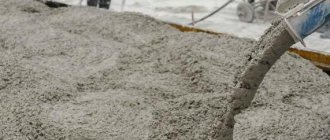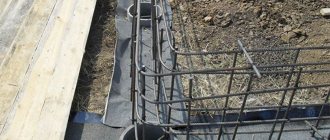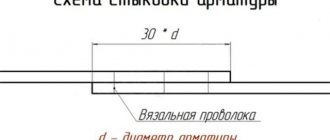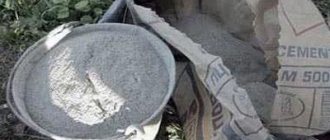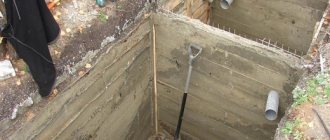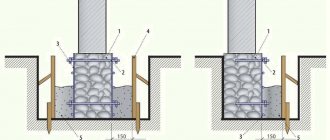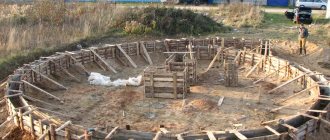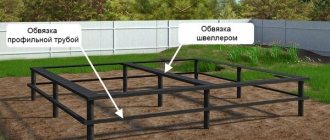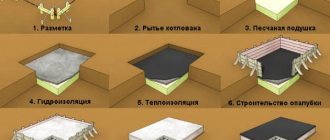Concrete solutions are used to construct the foundation, erect walls and fill the floor. Before starting activities, it is important to choose the design of the foundation, correctly calculate the overall level of costs and determine the required amount of building materials. Knowing how to calculate the volume of concrete, you can determine the estimated cost of construction activities, accurately plan the duration of concrete work and avoid unexpected costs. Let us dwell in detail on the methodology for performing calculations for various types of foundations, as well as walls and floors.
Strip foundation diagram
What methods can you use to calculate the volume of concrete?
Construction work is preceded by project development. At this stage, the type of foundation base is determined, and the volume of concrete solution required for the construction of the foundation is calculated. At the design stage, the need for mortar for pouring monolithic walls and concrete floors is calculated. The cubic capacity of the concrete mixture required to complete the work is determined by the volume of the building structures being concreted.
Various methods are used to perform calculations:
- manual. It is based on calculating the volumes of the foundation, main walls and floor. The calculation is made using a regular calculator using school formulas for calculating volume and does not take into account the shrinkage coefficient of concrete. The resulting value differs slightly from the results of calculations using software;
- program. The initial data entered into the program about the type of foundation, its dimensions, design features and concrete grade are quickly processed. As a result, a fairly accurate result is produced, which you can use as a guide when purchasing building materials for constructing a foundation base, building walls or pouring a floor.
Features when calculating the volume of concrete
To obtain an accurate result, it is not enough to take into account only the internal size of the formwork. The second method is more accurate, since the online calculator takes into account all the data: type of foundation, cross-section of the foundation base, presence of reinforcement cage and brand of mortar.
Getting ready to determine the volume of concrete - how to calculate without errors
When preparing to perform calculations, you should remember that the need for a concrete mixture is determined in cubic meters, and not in kilograms, tons or liters. As a result of manual or software calculations, the volume of the binder solution will be determined, and not its mass. One of the main mistakes that novice developers make is performing calculations before the type of foundation has been determined.
The decision on the foundation design is made after completing the following work:
- carrying out geodetic measures to determine the properties of the soil, the level of freezing and the location of aquifers;
- calculations of the load capacity of the base. It is determined based on weight, structural features and natural factors.
How to calculate the amount (volume) of a concrete mixture
It is easy to calculate the volume of concrete using a special program or online calculator that takes into account many factors :
- type of foundation being constructed;
- dimensions of the foundation, its configuration;
- brand of mixture used for concreting;
- depth of soil freezing.
The accuracy with which the volume of concrete is calculated depends on the data used for the calculation.
They are different for each type of foundation:
- when calculating the strip base, its dimensions and shape are taken into account;
- for a columnar base, it is important to know the number of concrete columns and their sizes;
- You can calculate a cube of concrete for a solid slab based on its thickness and dimensions.
The accuracy of the result depends on the completeness of the data used for calculation.
General information
To calculate a strip foundation you need length, height and width
When deciding on the preferred type of foundation, you must first find out what operational characteristics the soil has in a given area. The construction of a building without a preliminary study of the soil is fraught with its premature decommissioning. Before calculating a cube of concrete for the foundation, design its configuration taking into account:
- soil characteristics (composition, mobility, particle size, water level, tendency to heave);
- depth of soil freezing;
- structures of the building being constructed.
Based on the results of studying the soil, it is necessary to determine whether it can bear the design load. For example, if the soil is heaving, you cannot build a shallow belt structure on it. If necessary, changes are made to the planned dimensions of the base. Their values and reinforcement scheme determine how much concrete is needed for the foundation. These data are substituted into the calculation expression and the desired result is obtained.
Calculating cubic meters of foundation is important for economic reasons and for the reliability of construction. Particularly dangerous is an insufficient amount of mixture for a given volume: in this case, the base simply will not be able to bear the required load. If you purchase components for filling in large quantities, the resource costs will be excessive.
How to calculate concrete in cubes for a foundation
For all types of foundations, the need for concrete is determined by a formula that takes into account the total volume of foundation structures being erected. In this case, the part of the foundation that is poured into the ground must also be taken into account. To perform calculations, you should be guided by the dimensions specified in the design documentation.
Let's look at how to calculate the volume of concrete for various types of foundations:
- tape;
- columnar;
- slab;
- grillage
Determining the need for concrete mortar for each type of foundation has its own characteristics.
How to calculate a cube of concrete for a strip base
Strip foundation calculator
Strip foundations are quite popular. It is used for the construction of private houses, outbuildings and country houses. The structure is a solid ribbon of concrete reinforced with steel rods. The monolithic tape follows the contour of the building, including internal partitions.
Table of composition and proportions of concrete mixture
The volume of concrete for a monolithic strip foundation is calculated using the simple formula V = AxBxP. Let's decipher it :
- V – the need for concrete solution, expressed in cubic meters;
- A – thickness of the foundation tape;
- B – height of the belt base, including the underground part;
- P – perimeter of the formed strip contour.
By multiplying these parameters together, we calculate the total cubic capacity of the concrete solution.
Let's consider the calculation algorithm for a strip base with dimensions 6x8 m, thickness 0.5 m and height 1.2 m. Perform the calculation using the following algorithm:
- Calculate the perimeter by doubling the length of the sides 2x(6+8)=28 m.
- Calculate the cross-sectional area by multiplying the thickness and height of the tape 0.5x1.2=0.6 m2.
- Determine the volume by multiplying the perimeter by the cross-sectional area 28x0.6 = 16.8 m3.
The obtained result has a small error due to the fact that reinforced concrete reinforcement and shrinkage of the mixture during vibration compaction are not taken into account.
Strip foundation diagram
How to calculate the cubic capacity of a house foundation
Before pouring the foundation, you need to calculate its cubic capacity. This way you can avoid mistakes when purchasing components or ready-made concrete. By correctly calculating the cubic capacity of the foundation, you can save some of the funds that will be useful when building a house. This article will tell you how to calculate the cubic capacity of a foundation correctly with a simple calculator and a sheet of paper at hand.
What is the composition of the concrete mixture and how to calculate it
Before calculating a cube of concrete for pouring a foundation, you need to decide what grade of concrete is needed. So, knowing the cubic capacity, you can easily calculate how many kg of cement, sand or crushed stone you need. When making concrete, cement grade M 400 is used. It is suitable for the foundation for the construction of a house made of timber. There is a table of values for obtaining different grades of concrete:
Brand Components per cube of concrete, kg or l Cement Crushed stone Liquid Sand
| M 75 | 170 | 1053 | 210 | 945 |
| M 100 | 210 | 1080 | 210 | 870 |
| M 150 | 235 | 1080 | 210 | 855 |
| M 200 | 286 | 1080 | 210 | 795 |
| M 250 | 332 | 1080 | 215 | 750 |
| M 300 | 382 | 1080 | 220 | 705 |
But materials are usually delivered by car, then it will be easier to make the calculation in parts:
- M 75 – 1 cement +6 crushed stone +5.4 sand +1.2 water.
- M 100 – 1 cement +5 crushed stone + 4 sand + 1 water.
- M 150 – 1 cement +4.6 crushed stone + 3.6 sand + 0.9 water.
- M 200 – 1 cement + 3.8 crushed stone + 2.8 sand + 0.7 water.
- M 250 - 1 cement + 3.3 crushed stone + 2.3 sand + 0.65 water.
- M 300 – 1 cement + 2.8 crushed stone + 1.9 sand + 0.6 water.
For the convenience of readers, we provide a formula that will help you calculate the ratio of concrete components for the foundation of a wooden house yourself:
Cement 10%+ Crushed stone 45%+ Sand 25%+ Water 15%+ Air x5% = concrete mixture
Calculator for calculating cubic capacity
Large construction sites provide a calculator for calculating cubes of concrete for various foundation designs. Any of the following types is suitable for the construction of a house made of laminated veneer lumber and other types of lumber:
- Tape.
- Pile
- Slab
- Columnar
- Columnar-monolithic
In the type of foundation section, you need to indicate what structure is planned for the wooden house, how many floors the house will have, what the depth and width of the foundation is, and the computer will do the calculation on its own. Working with such a calculator is easier and faster.
In addition, in order to make a basic calculation, you need to remember the mathematics program for the 8th grade, and this is difficult with today’s pace of life. Especially if the work has nothing to do with calculations. The calculator on the site cannot be replaced in such cases. But it's worth considering. That such a machine will not make calculations with the geodesy features of the area and will not be able to take into account other nuances.
A similar calculator program is available in all construction companies. By contacting there you can count on the help of professionals. Moreover, you can calculate not only the volume of concrete for the foundation, but also the amount of materials, the volume of the gravel bed, the area of the formwork and reinforcement. But if you have enough knowledge and a regular calculator at hand, you can do all the calculations yourself. You can read more about such calculations below.
How to do the calculation yourself
Any calculation of the cubic capacity of the foundation is done based on the basic formulas: width x height x length = volume or area x height = volume. But if the shape of the foundation is not even, like a parallelepiped, then I use the trapezoid formula: (Bottom width + Top width)/2 x height x length = volume.
All dimensions need to be measured when the formwork is ready directly on it. But you can see the specified dimensions in the house plan if the foundation was protected there. If not, then you can draw a foundation diagram yourself and perform calculations on it. When calculating, it is important to take into account all elements that can affect the cubic capacity, such as stiffeners. When calculating each foundation design, there are subtleties.
Cubic capacity of slab structure
This type of foundation consists of a single slab located under the house. It is easiest to calculate a slab foundation. It is enough to draw a parallelepiped and calculate its volume. Therefore the formula will be: Area x height = volume. So if the width of the foundation is exactly 15 meters, the length is 10 meters and the height is 1 meter, then it turns out 10 x 15 x 1 = 150 m3.
If the planned foundation has additional stiffeners, then they need to be calculated separately and added to the main figure. For example, 3 stiffening ribs are planned, 5 meters long, 0.2 meters wide and 0.25 meters high. The volume of concrete on these ribs is 5 x 0.2 x 0.25 x 3 = 0.75 m3. But we know that the total cubic capacity is 150 m3, which means that 150.75 m3 of concrete is needed for construction.
If there are voids in the foundation, then their total volume is also calculated separately and subtracted from the total.
Capacity of the strip base
A strip foundation is most often installed for the construction of a house made of profiled timber or rounded logs. Since the structure is lightweight and does not require a reinforced foundation. It is more difficult to calculate.
Moreover, the height of the strip foundation may depend on several factors at once (depth of water, uneven terrain, etc.), which may differ for one foundation. So the height will be different everywhere. The width may also vary depending on the complexity of the design.
Moreover, the strip foundation can be either rectangular or in the form of a trapezoid, narrowing, or expanding towards the bottom. You need to calculate the volume based on its shape.
In such cases, areas with identical indicators are combined and their volume is calculated separately, and then summed up. The length of the foundation is calculated not by its length, but by the average figure between the outer walls of the formwork. This way you can avoid unnecessary costs for concrete. In this case, the volume of all voids is subtracted from the total volume.
Cubic capacity of columnar base
When calculating cubic capacity in this way, you need to take into account what shape the column has. It can be square, four-sided truncated pyramid or round. The volume of a cylinder should be calculated using the formula: Pi x radius 2 x height = volume. The number Pi is always equal to 3.14. For example, a pillar has a height of 2 meters, its radius is 0.65 meters. We calculate the volume of concrete cubes: 3.14 x 0.622 x 2 = 2.41 meters3 per 1st column. We multiply this number by the number of pillars and get the required volume of concrete.
If there is a strapping between the pillars, then its volume is calculated separately and the number of columns is added.
In order for the calculations to be carried out correctly, so that it does not turn out that in the end there is not enough solution or extra money is spent, a number of subtleties must be taken into account:
- For any work, concrete loss will be 5-8%. This must be taken into account when calculating.
- Instead of crushed stone, you can add ASG to concrete so the solution will be cheaper.
- For a wooden house, a foundation depth of 0.5 m is sufficient, since the structure is light.
- For the construction of a one-story country house from timber, a mortar of M 150 will be used, for a residential building over M 200.
- It is always more expensive to purchase ready-mixed concrete.
No matter how the calculations are made, on a calculator or by hand, you need to recalculate and check the result several times. For any minor change in the foundation design, the calculation should be carried out again.
Source: https://o-bruse.ru/fundament-2/kak-rasschitat-kubaturu-fundamenta
How to calculate a cube of concrete for a pile-type foundation
The base in the form of concrete columns is one of the simplest. It consists of reinforced concrete supports evenly spaced along the contour of the building, including at the corners of the building, as well as at the intersection of internal partitions with walls. Some of the supporting elements are located in the ground and transfer the load from the mass of the structure to the soil. The calculation algorithm involves determining the total need for concrete by multiplying the volume of individual columns by their number.
For calculations, use the formula – V=Sхn, which is deciphered as follows:
- V – amount of solution for filling columns;
- S – cross-sectional area of the support element;
- n – total number of pile columns.
Using the example of the requirements of a project involving the installation of 40 piles with a diameter of 0.3 m and a total length of 1.8 m, we calculate the required amount of concrete:
- Calculate the area of the pile by multiplying the coefficient 3.14 by the square of the radius - 3.14x0.15x0.15=0.07065 m2.
- Calculate the volume of one support by multiplying its area by its length - 0.07065x1.8=0.127 m3.
- Determine the required amount of mixture by multiplying the volume of one pile by the total number of supports 0.127x40 = 5.08 m3.
How to calculate a cube of concrete
If the support columns have a rectangular cross-section, to calculate the cross-section it is necessary to multiply the width and thickness of the element.
How is the cubic capacity of the foundation calculated?
Calculation of foundation cubic capacity (table)
Almost any existing foundation requires a competent calculation of the amount of concrete, reinforcement, wood for formwork, and other materials required for its construction.
But, without a competent calculation of the cubic capacity of the future foundation, it is practically impossible to predict the costs of constructing a foundation, especially since there are a large number of different types of foundations.
Accordingly, you have to remember the school mathematics course, look up formulas for the volume of structures, and only then sum everything up, multiply and divide.
But in any case, it is impossible to do without a detailed calculation of the cubic capacity of the future foundation, because it is this value that already leads to the calculation of the amount of cement, sand, reinforcement and other materials.
Why are such complex mathematical manipulations needed?
- When the overall dimensions of the base are known, it is easy to calculate the financial costs of excavation work;
- The cubic capacity of the pit in some types of foundations corresponds to the required amount of concrete solution;
- When there is cubic capacity, then the required amount of cement, sand and crushed stone is quickly calculated, especially in private construction;
- If you correctly calculate the cubic capacity of the foundation, then there will be no overconsumption of building materials.
Monolithic slab base
Determining the volume of materials on a slab base
A monolithic base is a large rectangular slab immersed to a specific depth in the soil.
This means that calculating the volume of the slab will take a minimum of time, because using ready-made drawings of load-bearing walls you can calculate the length, width and thickness of the structure.
For example: the length of the foundation is 12 meters, width 7 meters, thickness 0.6 meters. As a result, the volume of the slab will be as follows: 12*7*0.6=50.4 m3.
But this volume does not entirely correspond to reality, because any monolithic slab has a reinforcing mesh. You can also calculate the total volume of all the rods and trim and subtract it from the total volume of the foundation.
But in private construction no one makes such detailed calculations, because the total volume of reinforcement is rarely more than 1 cubic meter.
How to calculate concrete for a columnar base with a reinforced concrete grillage
To increase the strength characteristics of the columnar base, the protruding parts of the supports are combined with a reinforced concrete structure, which is called a grillage. It is made in the form of a solid reinforced concrete strip or slab in which the column heads are concreted.
When deciding how to calculate concrete in cubes for a grillage, you must perform the following operations:
How to calculate the volume of concrete for the construction of strip foundations and piles
- Determine the cross-sectional area of the grillage by multiplying its thickness by its height;
- Calculate the volume of the grillage by multiplying the cross-sectional area by the length of the structure.
The obtained value corresponds to the need for concrete mixture for concreting the grillage base.
How to correctly calculate the volume of the foundation
One of the main calculations when designing a future home is calculating the volume of the foundation, because the construction of any structure begins with the construction of the foundation. Let's figure out how to calculate the volume of the foundation. To do this, you need to take into account many indicators.
One of the main calculations when designing a future home is calculating the volume of the foundation, because the construction of any structure begins with the construction of the foundation. Let's figure out how to calculate the volume of the foundation . To do this, you need to take into account many indicators.
This is the constant load of the house along with a lot of operational loads (the weight of engineering equipment, furniture, people who will live in the house, etc.). These include temporary loads of snow cover and wind. You also need to calculate the supporting area of the foundation, which, in addition to the total weight of the house and foundation, depends on the soil.
For accurate calculations, designers use geological surveys of the soil, average temperature indicators in the region and the weight of building materials planned for the construction of the house. If construction is carried out independently, such accuracy is not needed, but an approximate calculation of the foundation of your house is necessary.
The cost of the entire project will depend on the amount of materials used. When it comes to the foundation, the main thing is to determine how much concrete will be needed to build it. The consumption of the foundation concrete mixture is measured in cubic meters, so it is necessary to calculate the volume of concrete for the foundation.
But before making the calculation, you need to determine the type of foundation that will withstand the total load of the building and will be better suited for the soil at the site of future construction.
Types of concrete foundations
Today, concrete mixture is used for the construction of almost all structures from which a house is built - frame, walls, ceilings and, first of all, the foundation. To determine its type, it is necessary to take into account the following basic indicators:
- massiveness and area of the building;
- type of building materials that will be used for construction;
- type of soil on the site;
- climatic conditions;
- availability of groundwater;
- soil freezing level.
After analyzing all these indicators, choose the type of concrete foundation. The most common types of concrete foundations are currently considered: strip, slab and columnar.
On many construction sites you can find a special service - a foundation cubic capacity calculator. This program helps you design the foundation of a building. With its help, you can calculate the amount of concrete solution required for the selected foundation option, the amount of formwork and reinforcement for the construction of the base structure.
Programs vary in complexity, but they all help to determine with great accuracy:
- Foundation area. Based on the data obtained, the required amount of waterproofing material for the finished base is determined.
- The volume of concrete and the required amount of mixture for the sand and gravel cushion.
- The amount of reinforcement for the base frame. Based on data on the diameter of the metal rods and their length, you can find out the exact weight of the reinforcement.
- The area of the formwork with the exact amount of timber in pieces and cubic meters.
- Cost of materials for the future foundation.
- Drawing of the structure being built.
With the help of such a calculator, the task of calculating the volume of the foundation is extremely simplified.
If you decide to do all the calculations on your own, take the measurements as accurately as possible. The quality of the work depends on this, since if there is a shortage of mortar, it will have to be ordered additionally, and this will affect the strength of the foundation, because It's better to fill it in one go.
Calculation of cubic capacity for a slab foundation
Since such a base is a solid rectangular structure, calculating its volume is very simple. The length and width of the base is multiplied by its thickness. The load-bearing qualities of such structures are equipped with stiffening ribs. The cubic capacity of such structures, which give the slab additional hardness, is calculated separately. To obtain the total volume of the required concrete mixture, the measurement results are summed up.
Strip foundation
If the section of the tape is the same along the entire length, it is enough to multiply the perimeter by the width and depth of the tape. If the transverse width or depth of the base differs in different areas, the cubic capacity of each area is calculated separately. The results obtained are summarized.
The width of the tape depends on the required area of foundation support and is equal to 20-40 cm. The depth of the tape (the height of the tape) is 40-50 cm, the total length is equal to the perimeter of the external walls plus the length of the tape that runs under the internal walls.
Columnar foundation
This is a structure consisting of supports, the shape of which has a rectangular or circular cross-section. To calculate the cubic capacity of such a base, first determine the volume of one column. For a parallelepiped, its length is multiplied by its width and height; for a cylinder, the square of its radius is multiplied by its height and 3.14 (the number “Pi”). The resulting value is multiplied by the number of pillars that will be needed to construct a columnar foundation.
Often its columns are connected to each other with a grillage to increase strength. Its volume is calculated according to the principle of calculating a strip foundation and summed up with the volume of concrete required for the construction of columns.
to calculate the volume of concrete for each type of foundation . You can do this yourself without any problems. After determining the amount of concrete needed for the job, you can calculate the cost of the foundation of the house.
Source: https://fundamentprofi.ru/izgotovlenie-fundamenta/kak-poschitat-obyom/
We calculate the volume of concrete for a foundation in the form of a solid slab
Slab-type foundations are used on difficult soils with high moisture concentrations. Buildings without a basement are erected on it. This design allows you to evenly distribute the load from the mass of the structure on the soil and ensure increased rigidity and stability of the object being built. The use of reinforcement can increase the strength of a slab foundation. The structure is a reinforced concrete slab in the shape of a rectangular parallelepiped.
How to calculate a cube of concrete for such a structure? It's quite simple using the following formula - V=SxL.
How to calculate the volume of concrete
Explanation of symbols:
- V – volume of concrete composition for pouring the slab;
- S – area of the slab base in cross section;
- L – length of the foundation structure.
For a foundation 12 m long, 10 m wide and 0.5 m thick, consider the calculation algorithm:
- Determine the area by multiplying the width of the slab by its thickness 10x0.5 = 5 m2.
- Calculate the volume of the base by multiplying the length of the structure by the area 12x5 = 60 m3.
The resulting value corresponds to the need for concrete mixture. If the slab foundation has a complex configuration, then it should be divided on the plan into simpler figures, and then the area and volume should be calculated for each.
Concrete calculation
When calculating concrete, it is necessary to take into account:
- geometric dimensions of the base;
- brand of material used;
- the number of additional jumpers for installing load-bearing walls between rooms.
When calculating a concrete base, the diameter and number of reinforcement bars should be taken into account. The number and cross-section of iron elements are calculated in accordance with the rules of SP 52-101-2003; the durability and strength of the foundation and the entire building depend on the quality of the elements. After determining the geometric dimensions of the concrete fragments, the parameters of the formwork are determined. When making formwork from boards, you should take into account the thickness of the material, which must withstand the weight of the poured concrete solution.
There are 2 ways to determine the volume of concrete mixture for foundations:
- The developer can use automatic calculators, which record information about the total length of elements and cross sections. A separate field indicates the type of reinforcement used and the number of rods. The calculators take into account the type of foundation and allow you to enter information about additional structural elements (for example, the number and cross-section of stiffeners in a slab structure).
- To verify the obtained figures, a manual calculation technique is used.
Strip foundation
When calculating concrete for a foundation using the formula V=H*B*L*k, the following parameters are taken into account:
- H—total shaft height (m);
- B—belt width (m);
- L is the total length of the base (m);
- k - correction factor taking into account losses during transportation and filling, is taken equal to 1.05.
For example, when arranging a house measuring 8 * 8 m with an additional load-bearing wall, a tape 0.6 m wide is used, buried 1.8 m into the ground. In this case, the volume of the mixture is determined by the formula (8 * 4 + 8) * 1.8 *0.6*1.05=45.4 m³. For a foundation 10 by 10 m with 2 additional walls and similar tape profile dimensions, the volume of cement mortar will be (10*4+10*2)*1.8*0.6*1.05=68 m³.
When using a strip structure with different thicknesses of external and internal elements, it is necessary to perform separate calculations of volumes. For example, there is a project for the foundation of a house measuring 6*8 m, which has an additional load-bearing bulkhead.
According to the design documentation, the external walls of the foundation have a thickness of 0.5 m, and the internal section is reduced to 0.38 m. The total height of the structure from the base recessed in the ground to the upper plane of the foundation is 1.8 m.
Calculation procedure:
- determine the volume of the external contour using the formula V1=(6+6+8+8)*1.8*0.5=25.2 m³;
- calculate the volume of the internal bulkhead using the equation V2=(6-0.5-0.5)*1.8*0.38=3.42 m³;
- calculate the total volume of the structure using the formula Vob=V1+V2=25.2+3.42=28.62 m³;
- take into account a 5% reserve for unplanned expenses and the error when assembling the formwork Vscor = Vob * 1.05 = 28.62 * 1.05 = 30 m³.
Columnar
The calculation method depends on the cross-section of the base elements:
- When using round supports, the formula V=L*3.14*R² is used, where R is equal to the section radius, and L is the height of the column (taking into account penetration into the ground). The result obtained is multiplied by the number of pillars provided for by the foundation design. A coefficient of 1.05 is introduced into the calculation, which allows you to adjust the unplanned costs of the concrete mixture. For example, for a column with a diameter of 0.5 m and a depth of 2.0 m, 3.14 * 0.25 * 0.25 * 2 * 1.05 = 0.42 cubic meters of cement-sand mixture are required.
- If the owner of a plot of land is faced with the question of how to calculate the amount of concrete for a foundation made of pillars of square or rectangular cross-section, then it is necessary to use the formula V=A*B*L. The equation takes into account the size of the sides of the post and the installation depth. For example, for a pillar with a square cross-section with a side size of 0.1 m and a length of 2.0 m, 0.1 * 0.1 * 2.0 = 0.02 m³ of solution will be required. The calculation takes into account the number of supports, and also introduces a correction factor of 1.05.
An example of a general calculation of a structure with a grillage for a house measuring 6*6 m, installed on 12 round piles with a diameter of 200 mm:
- Determine the volume of one support, which according to the design has a length of 1.8 m. For the calculation, the formula V = 3.14 * 0.1² * 1.8 = 0.057 m³ is used.
- You can calculate the cost of concrete for 12 piles using the equation Vob=V*12=0.68 m³.
- Since the project involves the installation of a reinforcing belt around the perimeter with a width of 400 mm and a height of 300 mm, the concrete for the grillage is calculated using the formula Vр = (6+6+6+6)*0.4*0.3=2.88 m³.
- Determine the total volume of the structure using the equation V=Vob+Vр=0.68+2.88=3.56 m³. Take into account the margin of 5%, as a result, 3.56 * 1.05 = 3.74 m³ of solution will be required to fill the foundation. By analogy, any columnar foundation assembled from round or rectangular elements is calculated.
Slab
The amount of concrete for the foundation of a slab structure is calculated from the thickness of the structure from 0.1 m (the thickness is determined at the design stage based on the soil parameters and the characteristics of the building). For example, for a residential building or office space measuring 8*10 m, you will need to order and deliver at least 8*10*0.25=20 m³ of the mixture.
The formula is correct for slabs of a flat configuration, but when arranging trapezoidal stiffeners (directed upward or downward), additional material must be taken into account.
An approximate algorithm for calculating the need for mortar when arranging a slab-type foundation:
- Determine the volume of the flat base, taking into account the area and thickness of the slab.
- Calculate the volume of each trapezoidal reinforcement beam, which is determined by the formula V=S*L (where S is the cross-sectional area and L is the length of the rib). To determine the area, the equation S=H*(A+B)/2 is used, where H is the height of the edge of the figure, and A and B are the length of the bases of the geometric figure.
- Determine the volume of all reinforcing elements, and then calculate the total volume. Since loss of solution is possible during transportation or pouring of the base, it is recommended to introduce a correction factor of 1.05 into the calculations. Based on the obtained measurements and coefficients, the developer can calculate how much concrete will be needed to construct a flat foundation.
For example, the owner needs to determine how much concrete is needed for the foundation of a house measuring 10 by 10 m, which has 6 reinforcements in the form of an isosceles trapezoid with a height of 200 mm and bases of 300 and 100 mm. At the first stage, the amount of mixture for a flat slab 10*10*0.1 m=10 m³ is determined.
Then the volume of the beam is calculated using the formula 10*0.2*(0.3+0.1)/2=0.4 m³, but for 6 amplifiers you will need 6*0.4=2.4 m³. The total costs of the cement-sand mixture for the foundation are equal to (10+2.4)*1.05=13.02 m³.
How to correctly calculate a cube of concrete for building walls
Calculator for calculating the amount of concrete for a strip foundation on the website
To build massive buildings, strong boxes are constructed from concrete reinforced with steel reinforcement. To determine the need for building materials, builders are faced with the task of calculating the volume of concrete for such structures. To perform calculations, use the following formula – V=(S-S1)xH.
Let's decipher the notation included in the formula:
- V – the amount of concrete mixture for the construction of walls;
- S – total area of the wall surface;
- S1 – total area of window and door openings;
- H – height of the concrete wall box.
When performing calculations, the total area of the openings is determined by summing up the individual openings. The calculation algorithm is reminiscent of determining the need for concrete for a slab foundation and can easily be done independently using a calculator.
How to calculate a cube of concrete for pouring a floor
How to calculate the volume of concrete for a floor
To increase the load-bearing capacity of the floor and ensure its flatness, a concrete screed is used. After the concrete has hardened, this surface serves as the basis for laying floor coverings or ceramic tiles. To prevent cracking, the thickness of the concrete screed being formed is 5–10 cm. This is due to the fact that thinner material cracks during operation. It is important to correctly calculate the cube of concrete so that the formed screed is strong and has the thickness specified by the project.
The formula for determining the amount of solution V=Sxh is easy to decipher:
- V – amount of material being poured;
- S – total area of the concrete screed;
- h – thickness of the concrete base.
Let's figure out how to perform calculations for a room with dimensions of 6x8 m and a concrete base thickness of 0.06 m:
- Determine the floor surface area by multiplying the length and width of the room - 6x8 = 48 m2.
- Calculate the volume of concrete to be poured to form the screed by multiplying the area by the thickness of the layer - 48x0.06 = 2.88 m3.
Guided by the above algorithm, you can easily determine the amount of concrete composition for concreting the floor. Situations arise when the rough surface has a slope. In this case, the formed screed has a different thickness according to the area of the room. In this situation, you can use the average layer thickness, which reduces the accuracy of the calculations.
